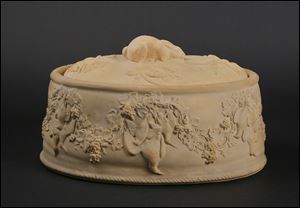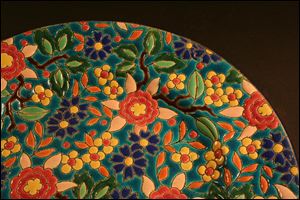
Ann Arbor museum celebrates all things plates, functional or not
5/17/2015
Carney
ANN ARBOR — You likely take the plates in your kitchen cupboard for granted, simply serving meals on them before loading them into the dishwasher.
You might take extra care with your wedding china, bringing it out only for holidays and then washing it by hand before storing it again.

Carney
But dishes in all their myriad variety — from the elegant to the eccentric, and particularly the exotic — are Margaret Carney’s true passion.
She is the founder and director of the Dinnerware Museum in Ann Arbor, which will celebrate its third anniversary in June. The collection boasts 3,500 pieces, from plates to glassware, from serving dishes to teapots, from fine art works to utensils for babies.
And, in particular, Ms. Carney said, “I absolutely love items that are dinner-related but not functional.”
Ms. Carney is a historian specializing in ceramics, who earned her master’s and doctoral degrees in the history of Asian art and her bachelor’s degree in anthropology and archaeology. She has curated dozens of exhibitions and written extensively, in addition to having taught ceramic world history at the New York State College of Ceramics at Alfred University, where she founded the Museum of Ceramic Art.
What is Ms. Carney’s favorite, of all these wildly eclectic items in her museum’s collection?
“My current favorite is whatever I’m obsessed with,” she said. “Now pie dishes.”

An English Wedgwood large game dish with liner and rabbit finial, 19th century.
The museum has recently acquired a large Wedgwood game dish from the 19th century, one that is in exceptional condition. It’s “so rare,” said Ms. Carney, “to have all the parts survive intact.”
Ceramic game pie dishes were used for serving meat and vegetable “pies” without crusts, starting in the late 18th century when flour prices were exorbitant due to the Napoleonic wars. Fillings were baked in the dishes’ liners and then brought to the table in the elaborately decorated beige-brown containers, because people wanted their dinner tables to look as beautiful as possible even during times of hardship.
The museum also owns plastic replicas of food, which are popular display items in Japanese shops, and a fragile sugar lamb, with sugar sculpture being a traditional European craft. Everything from the silly to the sublime, as long as it’s dinnerware or food-related, may very well find its way into the collection.
In fact, Ms. Carney’s assortment even includes unique items that will set a Geiger counter a-flutter.
“I have uranium glass ... it fluoresces under a black light,” she said, and dates “probably from the ’30s.”
She also has dishes — some of which she has found, and others which have been given to her by those who are concerned about safety — that could be considered hazardous if used for eating. Fiestaware, to be precise.
“Only the orange Fiestaware from the ’30s is radioactive,” she said. All the “other colors are fine.”
You would certainly expect that someone this knowledgeable (and contagiously enthusiastic) about dishes would not simply pick up random plates at the dollar store. Ms. Carney’s own everyday dishes were designed by Hungarian-born ceramicist Eva Zeisel, who once declared herself “a maker of useful things,” many of which are in museum collections around the world.
“She lived to 105, and at 104 she was still designing things,” Ms. Carney said.
A Toledo resident for nine years before moving to Ann Arbor in 2012, Ms. Carney worked as the director and curator at the Blair Museum of Lithophanes at the Toledo Botanical Garden.
A vegetarian with a persistent sweet tooth, she fondly remembers Bakery Unlimited: “They make those killer frosted cookies.” She is a runner, to burn off the cookie calories, and she has “had no chocolate or caffeine since 1987.”
Ms. Carney’s first “food memory was in Ann Arbor,” she said. She remembers that her grandfather was sick, and that her grandmother had offered her some ice cream if she behaved well and let him rest. She must have been a good girl, because Ms. Carney said that her grandmother served the promised ice cream “on one of those old enamel tables.”
Bill Walker, Ms. Carney’s husband, is a ceramics engineer and manager of ceramics development at the Federal-Mogul Corporation in Plymouth, Mich. He once “worked as a modeler at Hall” — The Hall China Co. in East Liverpool, Ohio — she said.

French, 20th century, Longwy Ware plate, after 1930 earthenware, enamels, and glaze.
“When he got his PhD,” she gave him a Longwy Ware enameled plate, a cherished gift from one ceramics enthusiast to another.
That vividly-colored French plate will be in the museum’s Delicious Dishes exhibit that will be hosted by the Riverside Art Center, 76 N. Huron St. in Ypsilanti, Mich., from Aug. 6 to 29.
The Dinnerware Museum doesn’t have a permanent facility, relying upon what Ms. Carney calls “pop up” exhibits in varying locations that offer or rent space for the shows. Those items not on display in a facility are carefully shelved in storage: “The third floor and basement” of her own home “are totally filled,” Ms. Carney said.
But “I’d like to have a permanent space by 2017,” she said, “with a gift shop, so we can have revenue coming in.” Currently, the museum relies solely upon donations and memberships for funding.
In addition to the gorgeous Longwy plate, the Riverside exhibit will include tea cups designed by Alleghany Meadows. Nesting together in a circle, the shape of the set is reminiscent of a bundt pan.
A limited edition of black-and-white dishes bearing a design by famed Pop artist Roy Lichenstein will also be available for viewing, along with a set of ceramic pieces by John Glick. Mr. Glick was commissioned by Joan Mondale to create dishes for the vice president’s home, during Walter Mondale’s term in office. Twenty-four sets were made, with three kept in reserve by the artist; The Dinnerware Museum acquired one of those three.
A nondish item, Sandy Skoglund’s photograph The Cocktail Party, will also be shown. This artwork is two-dimensional and not utilitarian. It is a scene of figures and furniture coated very deliberately in swirls of puffed, rather than crunchy, Cheetos.
Another exhibition — A Place at the Table — will be on display at the Gifts of Art Gallery at the University of Michigan Comprehensive Cancer Center, 1500 E. Medical Center Dr., Ann Arbor, through Dec. 15. A wide array of designs and patterns is showcased, from a set of white Glidden Pottery stoneware hand-painted with a black poodle motif to Sebring Pottery’s elegant gold-trimmed china featuring a pattern called Toledo Delight.
Whether visitors see the Ypsilanti show or the one at the university, there will be a mix of things that are “familiar and unique.”
“It’s stuff that I figure people haven’t seen before,” Ms. Carney said. “People will see something that will surprise them. It won’t just be ’grandma’ dishes.”
For more information about The Dinnerware Museum, go to dinnerwaremuseum.org or call 607-382-1415.
Contact Mary Bilyeu at mbilyeu@theblade.com or 419-724-6155.